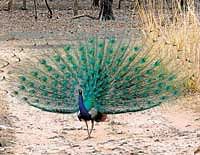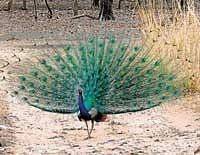
In the vast sprawl of Haryana's arid zones, peacocks have been a colourful company for villagers. Perched on rooftops and trees or prancing merrily around the sharply depleting foliage in the countryside, peacocks have co-existed peacefully with humans.
Over the years, however, as the human habitats expanded exponentially in the countryside, the sightings of peacocks have suddenly become a rarity in most villages. While no peacock census has been held in India to assess their numbers, a scientific survey by the Wildlife Institute of India, Dehradun, has confirmed that visibility of the bird has sharply declined throughout India.
The survey findings resulted by culling information collected from panchayats, birdwatchers, NGOs and state governments. Haryana is one of the peacock-rich states in the country along with Rajasthan, Punjab, Uttar Pradesh and Gujarat.
"Every morning and in the evening, droves of peacocks could be seen around our houses during our childhood. It was a soothing sight. Nowadays, we feel lucky to chance upon the bird in our vicinity," says Dheeraj Sharma belonging to Banipur village in the southern Haryana district of Rewari.
A protected bird under the schedule I of the Wildlife Protection Act, 1972, India's national bird is facing tough odds in survival stakes in Haryana's hinterland. Not surprisingly, man is a key imponderable in this battle of life and death for the beautiful bird.
Not too long ago, 150 peacock deaths were reported from Sharma's neighbouring villages in Rewari and the adjoining Narnaul districts- most of them due to electrocution. It is a pattern being noticed in several peacock deaths in Haryana where the birds fall victim because of non-insulation of high tension wires.
"The government has been promising to insulate electric wires in villages. But nothing has been done despite a large number of peacock deaths," says Naresh Kadyan, president of the Haryana chapter of People for Animals (PFA).
There are umpteen cases where packs of peacocks have been electrocuted. Other reasons for the dwindling peacock population are deaths attributed to consumption of pesticides thrown in fields by the farmers and poaching for feathers and meat.
Thankfully, redemption for the beleaguered bird seems round the corner after a spurt in peacock deaths across the state in recent years alerted the state's Forest and Wildlife Department.
For the first time, a conservation and breeding centre for the peafowl (Pavo Cristatus) is being set up in Haryana. Located at Jhabuwa in Rewari district and spread over an area of 60 acres, the aim of the centre would be breeding and soft release of peacocks in natural and undisturbed habitat.
"The breeding centre is being set up to address the problem of declining population of peacocks. One of the reasons for increasing mortality rate of the bird is growing interference in their biotic atmosphere. The centre will overcome that by providing a natural habitat for them to grow," says the state forest minister Capt Ajay Yadav. Three aviaries have been planned to be set up which would be kept free from all disturbances. One-year-old chicks carrying chips in their legs would be introduced at the Centre and their movement and behaviour would be constantly monitored through CCTV cameras.
Shiv Singh Rawat, in charge of the breeding centre said, "Mortality of peacocks is high compared to their fertility rate. It is a unique project to promote captive breeding of peacocks." Rawat attributed decreased sighting of peacocks to the shrinking of their natural habitats like ponds and trees.
While Rawat blames electrocution as the main reason for peacock deaths, he does not agree that poaching is a big issue.
However, Kadyan says that peacocks are being killed for their feather and meat by poachers.
The peacock is one bird where the male of the species is more 'deadly' than the female. That makes it more vulnerable too in the stakes for survival as the bird falls prey to poachers' greed to trade its feathers. Kadyan points out to a major flaw in the Wildlife Act that allows trading in peacock feathers as illegal. Under the aegis of International Organisation for Protection of Animals (OIPA), Kadyan has initiated a signature campaign by international community seeking amendment in the Act to ban trading in peacock feathers through a petition to President, Pratibha Patil. Thankfully, the Ministry of Environment and Forest has last week announced to amend the Wildlife Act to ban sale and trade in peacock feathers.
"So far, the Act allows trade in peacock feathers which attracts poaching. It is a welcome step by the Ministry to ban trade in peacock feathers.It is a major victory for our campaign," says Kadyan. Another problem is lack of conviction in poaching cases that are brought to courts. Haryana has set up environment courts at Faridabad and Kurukshetra. Kadyan says he has filed about 20 cases relating to peacock poaching but none has resulted in conviction.
